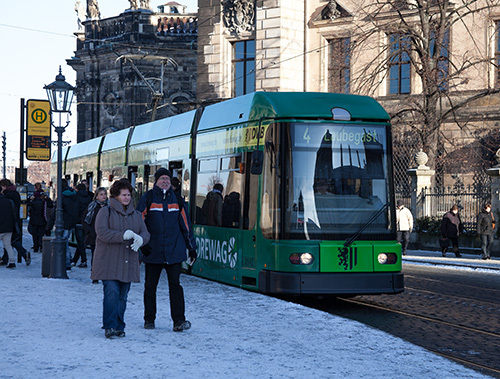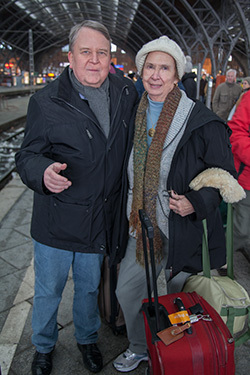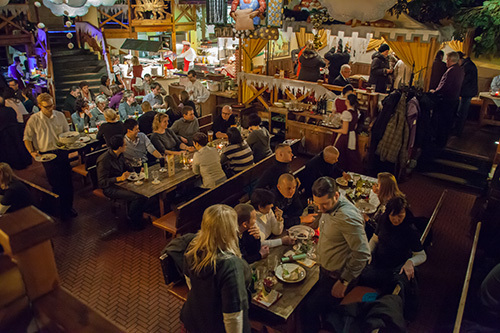Hey there, yes, you, the traveler with the phrase book. Are you touring Germany this summer? I'll bet you're planning to rent a car to get around. For Americans, driving is second nature, the right to go where we want, when we want, and damn the torpedoes.
Why don't most of us take the train? Well, you can blame the Auto Club for promoting road travel. Or the oil companies for getting us hooked on cheap gas (back when it WAS cheap). Or you could put the blame back where it really belongs: on us, stuck in a habit long past its use-date. Back in the day, Americans took to the rails with gusto, crisscrossing Woody Guthrie's prairies from east to west in comfort. You could board the San Francisco-bound train in New York or Chicago and expect springy window seats, an observation car and fine meals. For one price you'd get beds with fresh sheets and enough baggage-car space to bring your gorilla, no extra charge.
But the honeymoon was short. As America's road system reached every corner of the continent, passenger trains went out of style. But it didn't happen in Germany, then or now. Here (and in most of Europe), where cities and towns are close together, train travel is not just fast and convenient, but affordable, clean, and almost as comfortable as a limousine's rear seat.

"I don't drive," said my cousin Bert Noglik, blushing with embarrassment. A music critic and jazz festival impressario, he met our train from Berlin and was waiting on the platform in the Leipzig Bahnhof (train station) wearing a broad smile and a sporty winter jacket. Bert, who was born in Leipzig, lives in the house he inherited from his parents. When I asked how we were getting there, he apologized, as if a proper host would surely have a car waiting at curbside. "I don't even own a car," he said, taking my suitcase. "The street car runs ten minutes from my house, and for meetings in Berlin or Frankfurt, I take the train. If I'm going to London or Madrid, I fly."
If I lived in Leipzig I wouldn't have a car either. And as a tourist, I've found it both a 24-7 nuisance and an frivolous expense. If you were weaned on a race track, you'll think driving the Autobahn is a thrill. And a car will get you from town to town. But once there, it's a different story. Those old cobblestone streets, designed for horses and carriages, guarantee terminal gridlock. The very places you want to go -- historic city centers -- are a tangle of one-way streets and pedestrian walkways.
Just where do Germany's trains -- Deutsche Bahn -- go? Everywhere. The Deutsche Bahn system has 76,473 kilometers of track and stations in every town. Nor will you be stranded if you're staying at an suburban hotel or rural inn. Unless your destination is a mountain top, you'll find street cars, buses and taxis ready to take you those last few blocks. I keep a map and my hotel address in hand and never hesitate to ask a local resident for directions.
If your itinerary involves a long train ride, say from Berlin to Leipzig, and then to Stuttgart, you'll have to change trains, which may mean taking an indirect route. To avoid too many long rides (and to save on train fares), look at a map of railway routes and prices (see www.raileurope.com/europe-trains/deutsche-bahn/) and plan a route that that minimizes backtracking. That will leave more time to explore towns like Weimar, and to spend a rollicking evening in Dresden's Sophienkeller restaurant.
As for buying train tickets -- for first or second class, local or express, adult or youth, day or night -- you can buy them at any station without a reservation. For express trains between cities, and for most trains, you don't need a specific seat reservation. But there are exceptions. If the trains aren't busy, getting a seat is easy. But on holidays or in peak seasons (summer) trains will be very full. Many travelers prefer using a Eurail Pass, which is priced for your specific travel dates; buy it online before you leave home, at www.eurail.com. But first, sort through all of Germany's many routes, departure times, restrictions and prices, available at www.raileurope.com/europe-trains/deutshe-bahn and at www.germanrailpasses.com/planning/timetables . BAHN VOYAGE!
Between train trips, writer Anne Z. Cooke gets her kicks touring her cousin's model railroad layout.
Credit images to ColorWorld/Steve Haggerty